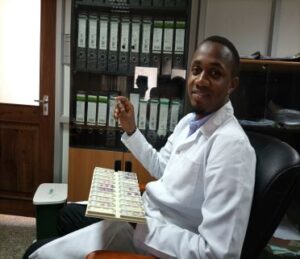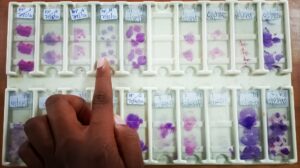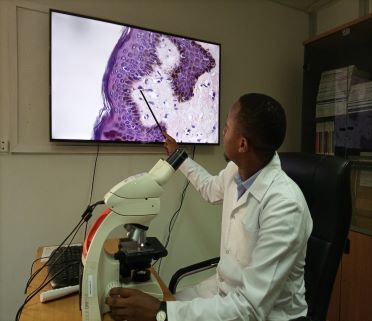You’ve visited the hospital with a nagging swelling on your skin. Your doctor suggests that a small part of the swelling will be sliced off so that a specialist can examine it and establish what you are actually suffering from. Do you know what kind of specialist will examine the tissue to diagnose the disease? It’s a pathologist.
One of the pathologist’s desires as a professional is to be able to make the most accurate conclusion about the disease affecting their patients. But in Tanzania, where one pathologist is available for more than 1.7 million people, it can be a tall order to satisfy that desire.
At hospitals in the country, a moment comes when a pathologist may have made a conclusion about a disease but s/he still needs a second opinion before signing it off—and the need for a quick consultation with colleagues emerges. What with the apparent lack of highly specialized molecular tests to confirm some tiny details about certain diseases, the work becomes even harder.
“What do you do when there are no specialists around to give you a second thought or no specialist at all to provide that service?’’ queries Dr Francis Zerd, a 30-year old medical doctor who graduated recently as a specialist in Anatomical Pathology from the Muhimbili University of Health and Allied Sciences(MUHAS).

Telecommunication-a game changer?
The shortage of pathologists in Tanzania and most other low-resource countries is increasingly becoming a drawback in detecting and confirming diseases, mainly cancer and nerve-related complications.
However, as technology advances, young professionals like Dr Zerd are seeing a glimmer of light at the end of the tunnel, banking their hopes on the use of telecommunication systems to solve the challenge.
Based at the Benjamin Mkapa Hospital in Dodoma, the country’s capital city, Dr Zerd’s job entails studying and analysing surgically removed organs, tissues, cells or the whole body to find out what exactly patients are suffering from. But he wishes this could be done in a more improved way by using telepathology in his country to save more lives and provide the highest level of specialized care.
And, what’s telepathology?
Currently on Dr Zerd’s mind are the strategies to promote telepathology—the use of real-time digital images to examine and detect diseases in patients’ body tissues but doing so from a distance.
He envisions a health system in Tanzania where pathologists—few as they are— can still deliver to their best, by leveraging the advancing world of technology in sharing information amongst themselves, for improved diagnosis.
Search for a solution
Dr Zerd’s interest in the study of diseases affecting the nervous system tissue (neuropathology) led him to find a digital solution for the country’s perennial shortage of super-specialized personnel in his field.
“I have been seeing many consultations via the internet during my practice. I had an interest in neuropathology but unfortunately there is no single neuropathologist in Tanzania to consult,’’ he says, recalling how he embarked on finding a solution; alongside experts from the United States of America.
“I was working closely with neurosurgeons at Muhimbili Orthopaedic Institute and that’s how I met an American neuropathologist and a neurosurgeon. We agreed that we could try promoting neuropathology here in Tanzania through sharing some difficult cases via the internet, and in the future we could train more pathologists in this area,” he says.
Technology hurdles
According to Zerd, one of the key challenges that pathologists in Tanzania face is the lack of molecular tests which can check for certain genetic changes in samples of tissue, blood or other body fluid. A molecular test helps a pathologist to establish the exact diagnosis.

“So, we tend to rely on the structure of the tissue as observed from a microscope and other non-molecular studies in making a diagnosis. Molecular tests can be needed when other studies and experts have failed to arrive at a diagnosis,’’ he tells MadicoPRESS.
What his study found
A recent study he authored reveals why telepathology can boost delivery of life-saving healthcare in Tanzania.
Published in the American Journal of Clinical Pathology, the study comes in the middle of projections that 70% of newly reported cancers will arise among patients in the developing world by 2030.
“Telepathology offers a promising means of providing diagnostic support, second opinion consultations, and ongoing training to pathologists practicing in resource-limited countries,’’ says the study coauthored by experts from the University of Colorado School of Medicine in United States and Muhimbili University of Health and Allied Sciences (MUHAS).
The researchers are recommending the adoption of static images in sharing of sample details for improved expert diagnosis, instead of the costly facilities such as robotic telepathology equipment that can be financially challenging for low-resource countries.
But it’s not all roses. Using static images, the study says, comes with some drawbacks because the transfer of the images among experts involves lack of control of magnification and focus by the receiving pathologist and is, therefore, highly dependent on the skill and training of the photographer.
The solution to this, the researchers say, lies in training a remote photographer in the effort to deal with the technical hiccups.
What other experts say
Dr Cosmas Mbulwa, a pathologist based at Bugando Medical Centre (BMC) in Mwanza tells MedicoPRESS that investing in the use of digital consultations and telepathology could reduce hospital-stays in regional hospitals.
“Using telepathology means there will be no need of transporting samples from one location to another. Patients will receive timely results of their diagnoses and this could reduce hospital-stays,’’ says Dr Mbulwa.
As Tanzania strives in training more pathologists to cover the human resource gap, Dr Zerd and his research team are upbeat that venturing into digital technology in pathology could be a game-changer in boosting timely delivery of specialized health healthcare to those who badly need it.
Reference:
Zerd. F (2020). Photomicrograph-Based Neuropathology Consultation in Tanzania: The Utility of Static-Image Teleneuropathology in Low- and Middle-Income Countries. American Journal of Clinical Pathology, 27 July 2020


I must say this is one of the best articles I’ve read this year! It’s amazing that regardless of a huge workload pathologists still are passionate about calling for improvements that will benefit patients.
I hope sooner than later that digital consultations and telepathology become the normal in our country for the sake of both the patients and the pathologists.
I also hope for more trained pathologists because considering the projection of a 70% rise in newly reported cancers in developing countries by 2030, the last thing we need is a shortage of the key personnel in diagnosing them!
Thanks once again for an amazing read, hopefully it will help creating more awareness thus contributing to solutions of the issue at hand!